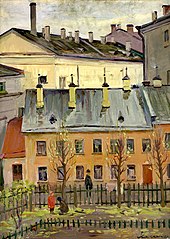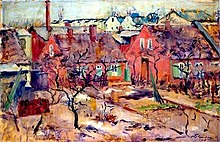Maria Slavona
Maria Slavona , actually Marie Dorette Caroline Schorer (* 14. March 1865 in Lübeck ; † 10. May 1931 in Berlin ) was a German painter of Impressionism . At her death she was considered to be the most important German painter of her time alongside Dora Hitz .
life and work
Marie Dorette Caroline Schorer came from a respected family of pharmacists in Lübeck. Her father Theodor Schorer was the owner of the Löwen pharmacy on Königstrasse . She grew up with five siblings in Lübeck. Her oldest sister Cornelia Schorer was one of the first German women to receive her doctorate in medicine.
education
At the age of seventeen, Marie Schorer came to Berlin in 1882 to train in painting and drawing . First she learned at the private painting school Eichler , before she soon switched to the educational establishment of the Royal Museum of Applied Arts , which she left in 1886. In 1887 she expanded her training at the school of the Association of Artists and Friends of Art in Berlin , since girls were also allowed to study anatomy here and draw from living models . The official Prussian Academy of the Arts , which also provided for such teaching elements, was still closed to women and girls. Her teacher, the portraitist and etcher Karl Stauffer-Bern (1857–1891), she attributed a great influence on her development.
From 1888 she continued her studies in Munich , the art city of the German Empire that had been newly founded 17 years earlier . Here she first learned from Alois Erdtelt and shortly afterwards attended the women's academy of the Munich Artists' Association , where Käthe Kollwitz was studying at the same time . Her teacher, the co-founder of the Munich Secession , Ludwig Herterich (1856–1932), left a formative impression . He introduced Schorer to French Impressionism . During a holiday in Lübeck she made the acquaintance of some Scandinavian artists, who encouraged her to go to Paris.
“In 1890 I came to Paris. A new world opened up to me here. The first visits to the Louvre almost numbed me. But I was disappointed with the schools I saw, I didn't like anything there. I decided to work alone and to seek advice and judgment only in the company of a few young like-minded friends, almost all of them Danes and Norwegians. "
The artist came to Paris in 1890 with the Danish painter Vilhelm Petersen (1868–1923), who later called himself Willy Gretor . Here she took her stage name Maria Slavona. The first years in Paris were marked by disappointments and financial difficulties. In addition, she had an illegitimate child with Petersen, the future actress Lilly Ackermann , who had to be looked after.
Artist life and work
Despite all adversity, she consistently turned to French painting and devoted herself to her art with enthusiasm. Familiarity with French painting is evident in the work of the Parisian years. She maintained close contact with the Parisian artist world, especially through her friendship with Camille Pissarro . As a painter, she eventually achieved recognition and approval. In 1893 she exhibited for the first time in the Salon du Champ de Mars , under the male pseudonym Carl-Maria Plavona, né à Varsovie .
In Paris she met the Swiss art dealer Otto Ackermann, whom she married in 1900. The couple ran a lively artist house in which artists and other personalities such as Edvard Munch , Walter Leistikow , Max Liebermann , Bertha von Suttner , Rainer Maria Rilke , Käthe Kollwitz and the young Theodor Heuss frequented.
She created many of her best pictures during her time in Paris. Her works were valued by collectors and were compared to Berthe Morisot . In 1907 the French state bought one of her landscape paintings. From 1901 she exhibited as a corresponding member in the Berlin Secession . As an early member of the German Association of Artists , Maria Slavona took part in the first joint exhibition with the Munich Secession in 1904: with the gardens in Montmartre and children's studies .
In 1906 Slavona moved with her family to Lübeck, the city of her birth. Here she painted numerous family portraits and Lübeck motifs such as the Lübeck corridor or the thaw near Lübeck . The latter painting was reworked after 1920. So the woman in the foreground has been removed.
From 1909 she lived in Berlin. In 1913 she became a full member of the Berlin Secession, after which it split up into the Free Secession led by Max Liebermann . Maria Slavona was considered a fighter for modern art in contemporary art criticism . French impressionism and a "North German sobriety" combined in her work, which is particularly characterized by the sensitivity of the coloring.
At the end of the 1920s, the artist's health deteriorated. She sought healing in anthroposophy and naturopathy. In her last creative phase, she mainly created flower paintings and landscapes near her Ammerland house. To mark its posthumous appreciation, the Nationalgalerie organized an exhibition of its works in the Kronprinzenpalais in Berlin in 1931 , which then went to nine German cities.
In memoriam
After her death, Slavona was forgotten as an artist for a long time. This must also be seen against the background that she was a representative of an art movement that was no longer desirable from 1933 during the National Socialist era . Modern artists and their works were in Germany by the conformist criticized public opinion devastating and many works as " degenerate art " stigmatized and destroyed on the instructions of the authorities or forcibly auctioned abroad. In addition, a large part of Slavona's work fell victim to the Second World War.
Exhibitions
- 1891: Participation in an exhibition at the Salon du Champ de Mars, Paris
- 1901: Participation in exhibitions as a corresponding member of the Berlin Secession
- 1904: Participation in the first exhibition of the German Association of Artists in Munich
- 1912: Galerie Paul Cassirer, Berlin
- 1920: Collective exhibition in the rooms of the Overbeck Society in the Schabbelhaus, Lübeck
- 1927: Solo show for her 60th birthday in the Great Berlin Art Exhibition
- 1929: Participation in the DKB exhibition in the State House , Cologne
- 1931: Posthumous appreciation of the National Gallery in the Kronprinzenpalais, Berlin; then traveling exhibition through nine other German cities
- 1981: Maria Slavona 1865–1931. A German impressionist. Bröhan Collection, Berlin and St. Annen Museum, Lübeck
- 2014: The exhibition in the Munich City Museum presented the broad artistic work of women like Maria Slavona in Munich around 1900 until February 8, 2015
- 2015: The special exhibition The Painters of Paris in the Edwin Scharff Museum in Neu-Ulm presented the artistic career of Maria Slavona and nine other painters of their time
Museum property
- Bröhan Museum , Berlin
- National Gallery Berlin
- Kunsthalle Bremen
- Museum am Ostwall , Dortmund
- Museum Kunstpalast , Düsseldorf
- Städel , Frankfurt am Main
- Kunsthalle Kiel
- Behnhaus Museum , Lübeck
- New Pinakothek , Munich
- From the Heydt Museum , Wuppertal
literature
- Margrit Bröhan: Maria Slavona 1865–1931. A German impressionist. Catalog. Collection Bröhan Foundation, Berlin and Lübeck 1981.
- Margrit Bröhan: Maria Slavona. In: The Hidden Museum. Part I: Documentation of the art of women in Berlin public collections. Berlin 1987, ISBN 3-926175-38-9 .
- Yvette Deseyve, Ralph Gleis: Struggle for Visibility. Artists of the Nationalgalerie before 1919 . National Gallery. National Museums in Berlin, Berlin 2019, ISBN 978-3-496-01634-2 , pp. 160-162 .
- Wulf Schadendorf: Museum Behnhaus . The house and its rooms. Painting, sculpture, handicrafts (= Lübeck museum catalogs 3). 2nd expanded and changed edition. Museum for Art a. Cultural history d. Hanseatic City, Lübeck 1976, p. 114
- City Papers ; Lübeck, March 18, 1920, article: Maria Slavona
- Ulrike Wolff-Thomsen: The Paris Boheme (1889 - 1895): An autobiographical report by the painter Rosa Pfäffinger , including section: II. Letters from Rosa Pfäffinger to Maria Slavona; Verlag Ludwig, Kiel 2007, ISBN 978-3937719399
- Kathrin Umbach: The painters of Paris. German artists on the move. , edited by Helga Gutbrod on the occasion of the exhibition of the same name at the Edwin Scharff Museum Neu-Ulm, Gebr. Mann Verlag, Berlin 2015, ISBN 978-3-7861-2749-9 , pp. 48–57
Web links
- Literature by and about Maria Slavona in the catalog of the German National Library
Individual evidence
- ↑ Yvette Deseyve, Ralph Gleis: Struggle for Visibility. Artists of the Nationalgalerie before 1919 . National Gallery. National Museums in Berlin, Berlin 2019, ISBN 978-3-496-01634-2 , pp. 160-162 .
- ↑ Quoted from: Margrit Bröhan, Maria Slavona, in: Das Verborgene Museum I, Berlin 1987, p. 164
- ^ Exhibition catalog X. Exhibition of the Munich Secession: The German Association of Artists (in connection with an exhibition of exquisite products of the arts in the craft) , Verlaganstalt F. Bruckmann, Munich 1904 (p. 30: Slavona, Maria, Paris).
- ^ Catalog of the Deutscher Künstlerbund Cologne 1929. May – September 1929 in the State House , M. DuMont Schauberg, Cologne 1929. (Catalog No. 286: Slavona, Maria, Berlin, Feldblumenstrauss , p. 31)
- ↑ Special exhibition Die Malweiber von Paris , homepage of the Edwin Scharff Museum, Neu-Ulm ( Memento of the original from October 9, 2017 in the Internet Archive ) Info: The archive link was inserted automatically and has not yet been checked. Please check the original and archive link according to the instructions and then remove this notice.
| personal data | |
|---|---|
| SURNAME | Slavona, Maria |
| ALTERNATIVE NAMES | Schorer, Maria |
| BRIEF DESCRIPTION | German impressionist painter |
| DATE OF BIRTH | March 14, 1865 |
| PLACE OF BIRTH | Lübeck |
| DATE OF DEATH | May 10, 1931 |
| Place of death | Berlin |





